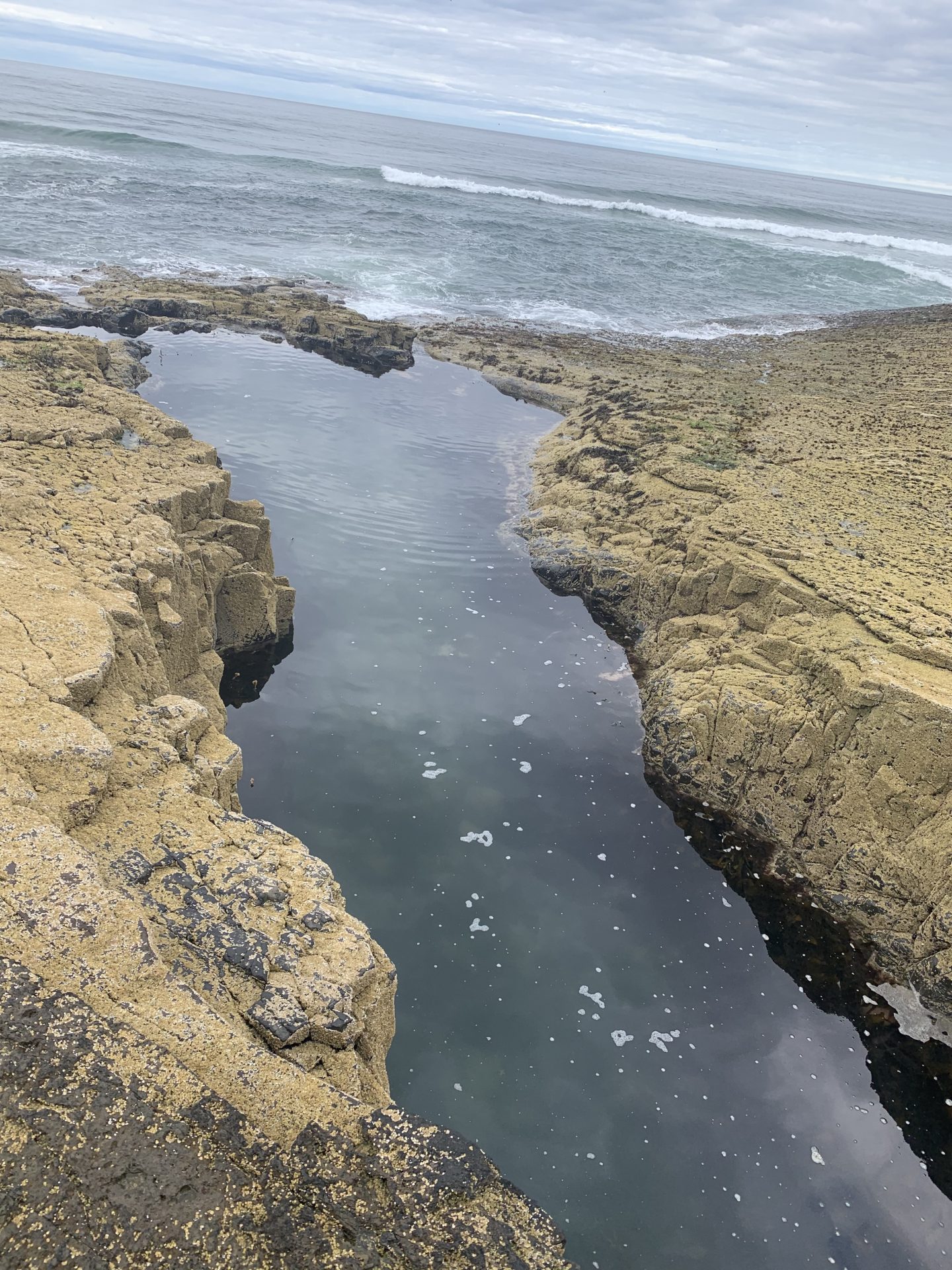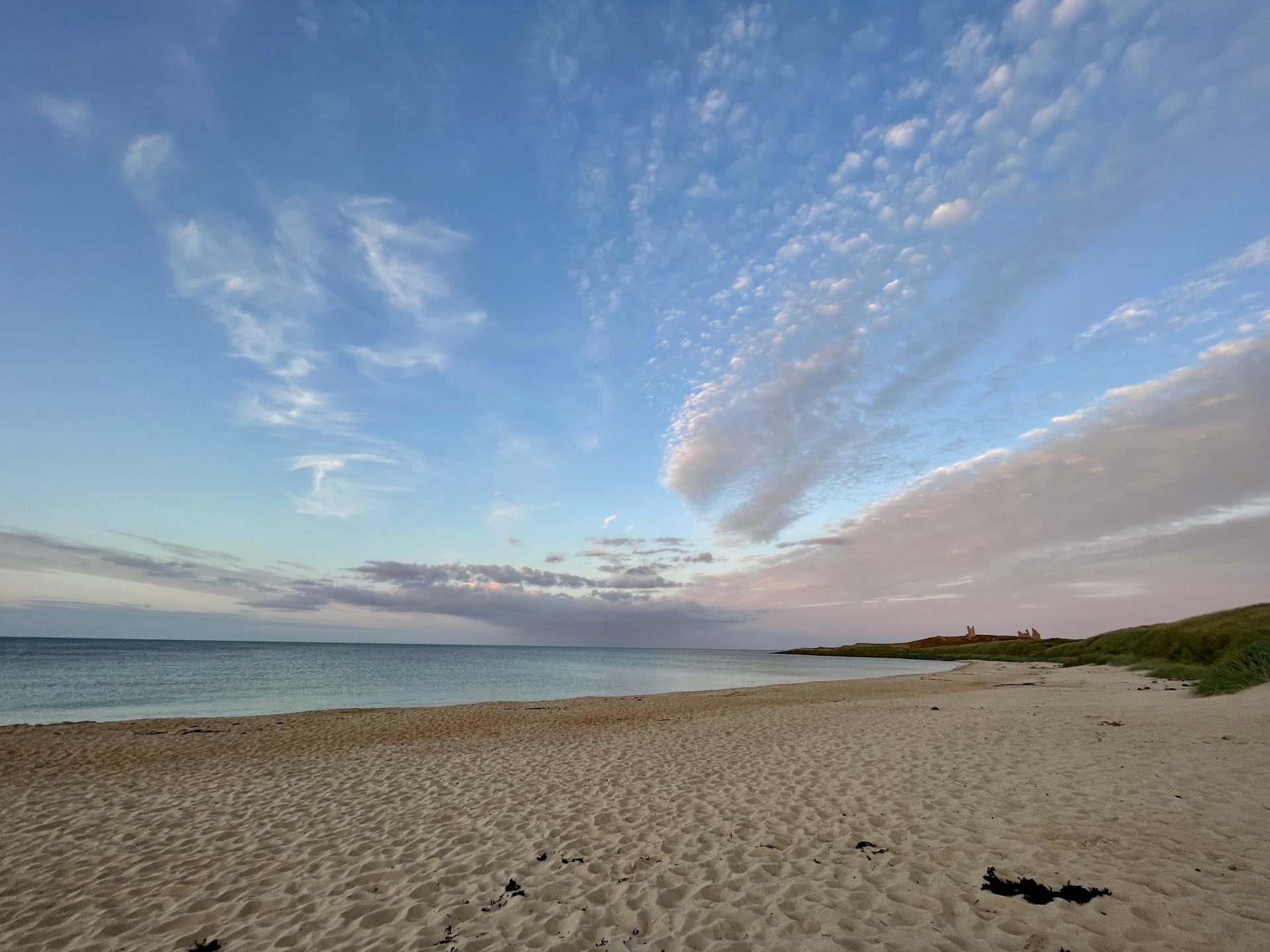“How cold water swimming has helped me to manage my auto-immune flare-ups”
Over the pandemic, it seemed like everyone was heading to their local body of water to espouse the ‘surprising’ benefits of cold water swimming. But for writer Helen Wilson-Beevers, discovering the North Sea has been transformative for helping to manage her auto-immune condition.
When summer first began, a friend invited me to join her for a swim in the sea. We live a 10-minute drive from the Northumberland coast, and she is one of a few people I know who raves about cold water swimming. The beach is my favourite place, and when any big decision needs to be made, I’ll head there. But I get cold easily and have always been daunted by taking the plunge. In all honesty, I hadn’t thought I could conquer that.
Yet, thanks to a painful auto-immune flare-up causing joint inflammation, I suddenly became really tempted. Could the energising benefits often associated with cold water swimming help me too?
I’d try anything to reduce the discomfort and pain, and this was the second good friend to suggest that sea swimming might bring relief. Sea swimming has also always sounded like a real social occasion and I needed that sociable boost.Figuring that I would be in safe hands going with an established sea swimmer, that Friday morning, we ventured to a nearby bay.
You may also like
Swimming benefits: “How swimming can help boost self-esteem for Black women like me”
The cold shock concentrates the mind, making it a mindful practice
Despite walking into the sea wearing a wetsuit, I was instantly hit by the aching cold which stung my hands and feet. I yelled at the dull pain but internally, I started to wonder if I could really go through with the swim. Concentrating on trying to stay calm, I remained in the water, managing to put my shoulders under and fill the wetsuit with a layer of water. I lay on the surface close to shore, surrounded by sloshing waves, becoming ever more aware of their potentially dangerous power when one crashed onto me.
That initial shock and, let’s be honest, discomfort, soon subsided. I began to feel sheer exhilaration – buoyed by the social element of braving this with other women as a shared experience. Concentrating in open water meant I couldn’t think about anything else at all, bringing momentary respite from whatever stresses were on my mind. Running out of the sea to head home, I whooped with the boost this dip had brought.

Foolishly, I hadn’t brought enough warm layers for dressing afterward, and even with my low cold tolerance, had underestimated just how freezing it would be. I’ll readily admit to getting a chill from naively staying in too long that day.
Experiencing long-lasting pain relief from sea swimming
The numbing pain relief was almost unbelievable, soothing my joint stiffness for a few days afterwards. I was taken aback by how intensely mood-lifting that cold water dip had been, while also releasing some fatigue heaviness. I quickly knew this activity would – against my initial scepticism – become a habit.
A fortnight later, we returned one evening in a larger group to celebrate my friend’s birthday. I arrived armed with thick, woolly, loose layers, a hat and a warm drink for afterwards. We watched the sun set from the sea, which was beautiful. Cautious to not feel too chilly, I got out much sooner than everyone else there.

Our next trip took us to a naturally formed rock pool, deep enough for dipping in at low tide. Clambering across the rough terrain from where we’d parked, tourists were watching the waves too. As the small pool had people in it, we waited for them to get out, before lowering ourselves in. My feet could feel the smooth flat base, and I marvelled at the waves angrily crashing onto its sides.
In this space, I swam easily thanks to the lack of a strong current. The temperature was nowhere near as cold as the open sea. Despite being a beauty writer, I’ve discovered that I’d much rather dip in that pool than at any five-star spa.
Just floating around or having a quick dip is enough to reap the benefits
My husband and I have shared sea swims too, sitting for a while afterward to chat on our sandy dates. One weekend, we’d been walking around town beforehand and my lower back was stiff and sore. I was almost in tears from the agony… but as soon as the sea water lapped over me, the pain instantly started to cool off. Driving home, I couldn’t stop remarking at how much better my movement was and how the sea had worked its magic yet again.
I currently do more floating and splashing around than serious sea swimming, so researching the safest places to accommodate that has paid off. From what I’ve read, however, even a few minutes of immersing yourself in the water can feel tangibly rewarding and have real benefits. Just being in under a cold shower for 30 seconds has been shown to reduce the likelihood of people calling in sick of work by nearly 30%, while the North American Journal of Medical Sciences confirms that cold water can have local anaesthetic-like effects on pain – reducing swelling and slowing the speed at which nerves transmit pain signals to the brain.

It’s weird to think that after such a short space of time, I now miss the sea if I don’t have a swim scheduled. I’m planning on continuing swimming through autumn and winter and have been told that October is the UK sea’s warmest month. I’ll be investing in some neoprene gloves and socks to stave off the chill past that point though. My long-term goal is a swimsuit-clad dip, so I can feel the cold North Sea water in full.
I’ve learned first-hand that the invigorating power of sea swimming has to be felt to be believed.
5 safety tips for sea swimming all year round
Never swim alone
“Always have someone with you,” advises open water swimming coach Alice Goodridge. “Even experienced swimmers can suddenly get cramp, swallow seawater, or unexpectedly feel anxious in the water,” she continues. “Stay together until everyone is out of the water, so that no one is left struggling to get dressed because they are too cold.”
Even if you can’t go regularly, join a local swimming group. “They will keep you in the loop, know the safest locations to swim and have their own routine which you can learn from. The Outdoor Swimming Society is a great resource, too.”
Do your research
“Sea swimming is impacted significantly by beach type, wind, currents, and tides,” says open water lifeguard and coach Ella Foote. “Learn about where you plan to swim, considering what time is high and low tide and how the sea behaves at these times,” she adds. “For example, does the beach shelve quickly or is it shallow and sandy? Check the weather, because out of season UK beaches are not lifeguarded.”
Goodridge emphasises the importance of planning your route: “A good choice for an entry or exit would be an area that you can get out of quickly if needed – preferably with fewer pebbles, seaweed, or rocks.” Finally, Foote says: “Make sure you know your location. Visit the RNLI and RLSS websites for safety guides and skills.”
Plan what to wear
“A brightly coloured hat and tow float will make you more visible,” advises Goodridge.
Foote explains: “Wetsuits are not essential for sea swimming but will keep you warmer for longer and more buoyant. When buying a wetsuit, check it is designed for swimming not surfing, and if you choose to swim in just a swimsuit, invest in a decent neoprene swim hat.
“Socks and gloves are an excellent way of keeping your extremities warmer for longer.”
Be prepared for the cold
Goodridge warns that you’ll always feel the initial shock of the cold on entry to the sea. “Take it nice and slow and gradually get into the water. Splash the water onto your skin or if you’re wearing a wetsuit, dip under it. Really focus on breathing deeply in and, most importantly, out..”
It’s also massively important to know your limits. “Do not be tempted to stay in too long. Never swim too far away from the shore as you risk struggling to swim back to the side due to cold incapacitation,” she says.
“Always stick close to the shore for your first few swims, and swim parallel to the shoreline so that you can easily get out if you’re starting to feel cold.” And the main rule of thumb, Foote finishes, is to “ensure that you are warm before entering the water and exit as you begin to feel the chill.”
Warm up efficiently
“The coldest you’re going to be is probably 15 to 30 minutes after you get out of the water, so get dressed quickly and wear lots of layers,” says Goodridge. “Baggy, easy-to-put-on clothes are the best. Tracksuit bottoms and T-shirts are ideal because as soon as you’re wet and cold it’s not easy to get changed,” she adds.
“However tempting it is, don’t go home and have a really hot shower straight away. Heat up gradually, have a warm, sugary drink and go for a walk to generate heat within the body.”
Ready for your first dip? Let us know how you get on by following us on Instagram (@StrongWomenUK).
Images: author’s own
Source: Read Full Article
